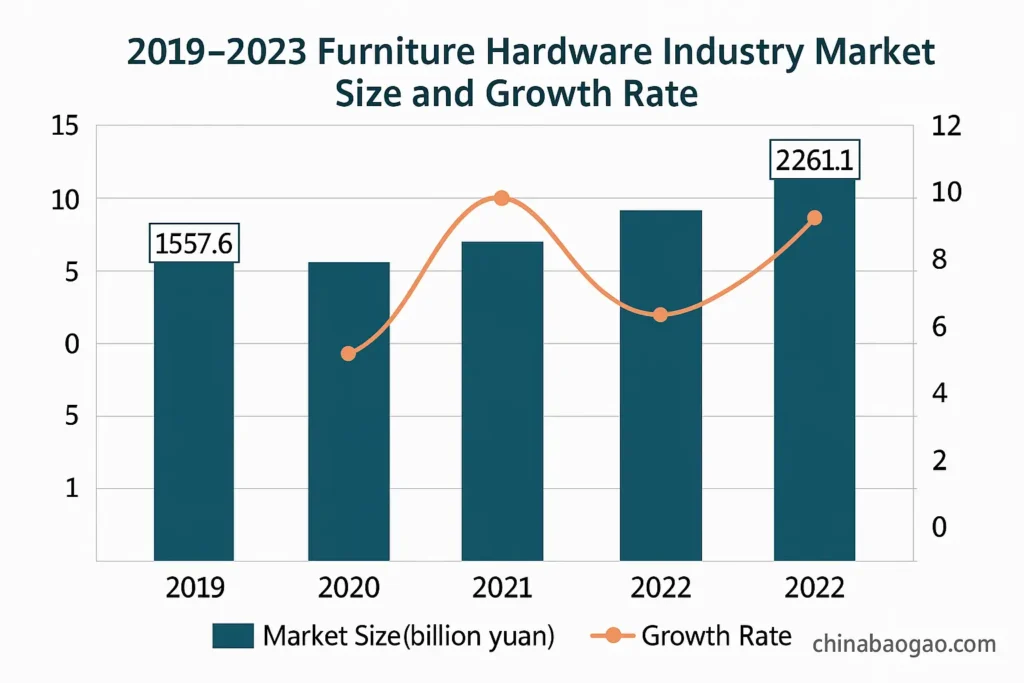The Future of Furniture Hardware:3 Powerful Trends in 2025
Posted by ALBERTGILL

In recent years, the scale of the home furniture hardware industry in China has been expanding continuously. Data shows that from 2019 to 2023, the market size of the home hardware industry in China has increased from 155.76 billion yuan to 226.11 billion yuan, with a compound annual growth rate of 9.8%.
After many years of development, the home hardware industry in China has shown mature manufacturing capabilities and a complete industrial chain, with the brand effect becoming increasingly significant and product innovation capabilities continuously enhancing. In addition, the industrial cluster effect and the advantages of large-scale production have further improved the production efficiency and resource utilization of home hardware enterprises, laying a solid foundation for the development of the home hardware industry in China.

Market demand situation
As an important supplier to the furniture hardware industry, the market space of home hardware is closely related to the development of the downstream home industry. For the home hardware industry in China, its market development mainly depends on the demand of the downstream domestic furniture industry and the demand for furniture hardware products from abroad.

Favorable Policies Open New Opportunities for China’s Furniture Manufacturing Industry
The furniture hardware sector in China is poised for further development and prosperity, driven by a series of supportive national policies. In July 2023, the Ministry of Commerce and 12 other departments jointly issued the Notice on Several Measures to Promote Home Consumption, encouraging local governments to align home renovation initiatives with the renovation of old residential communities. The policy supports residents in upgrading or partially renovating their old homes, aiming to integrate various initiatives to form a strong force in boosting domestic consumption.
In the same month, a meeting of the Political Bureau of the CPC Central Committee emphasized the need to actively expand domestic demand and enhance the foundational role of consumption in driving economic growth. It called for stimulating end-user demand to drive effective supply, with particular focus on promoting big-ticket consumption such as automobiles, electronics, and home furnishings.
In March 2024, the State Council issued the Action Plan for Promoting Large-Scale Equipment Upgrades and Trade-In of Consumer Goods, outlining four key actions: equipment renewal, trade-in of consumer goods, recycling, and standards improvement. This initiative will be backed by stronger financial, tax, land, energy, and technological support. The plan specifically includes the trade-in of durable consumer goods such as automobiles, home appliances, and home furnishings, encouraging enterprises to offer affordable products and services to meet diverse consumer needs.
Renovation Demand from Second-Hand Homes Becomes a New Growth Driver
The demand for renovation stemming from second-hand housing and secondary renovations is becoming a significant force driving the furniture hardware industry. Since China’s commercial housing reform in 2001, the total floor area of commercial housing sold has grown rapidly, and the inventory of existing housing has also increased. With that, the proportion of second-hand housing transactions has been rising.
In 2022, China’s second-hand housing transaction volume reached RMB 6.5 trillion, representing 41% of the total residential market value. At the same time, many unsold or non-transacted existing homes are aging, prompting homeowners to pursue renovations and upgrades. Together, these factors are fueling a surge in demand and unlocking new growth opportunities for the furniture hardware industry.
Smart Home Trends Open New Opportunities for Furniture Hardware
The increasing trend of smart home products creates new possibilities for the furniture hardware industry. Smart home functionality relies heavily on hardware components, which are now being integrated with sensors, voice and gesture control systems, and touch interfaces to enable intelligent control.
With the rapid development of new infrastructure, 5G technology, and AI applications in China, the Internet of Everything is becoming a key trend in economic and social development. This has created a strong opportunity for the smart home sector. Data shows that in 2022, the size of China’s smart home market reached RMB 651.6 billion, with a CAGR of 12.99% from 2018 to 2022. The market is projected to reach RMB 715.7 billion in 2023.
While the smart home penetration rate in countries like the UK and the US exceeded 40% in 2022, China’s penetration rate remained relatively low at about 16%, indicating substantial room for growth. As smart home solutions advance, the demand for smart furniture hardware will continue to grow, bringing fresh opportunities to the industry.
Conclusion
In summary, driven by supportive policies, growing renovation needs, and the smart home revolution, the downstream demand for furniture hardware in China will continue to rise. As the home furnishing and interior decoration industries evolve, the furniture hardware sector is well-positioned for long-term growth.
China is a major manufacturer of home hardware products. For a long time, Chinese home hardware enterprises have exported products to foreign countries or produced OEM and processing for foreign-funded enterprises, making China also a major exporter of home hardware products. Since 2017, the export value of China’s home hardware products has shown a continuous growth trend, reaching 150.95 billion US dollars by 2022.
In 2023, the export scale has decreased slightly to 136.67 billion US dollars. For a long time, Chinese home hardware enterprises have exported products to foreign countries or produced OEM and processing for foreign-funded enterprises, making China also a major exporter of home hardware products. By 2022, the export scale of China’s home hardware products has increased to 150.95 billion US dollars. With the gradual improvement of the global economic situation and the gradual recovery of related industries, global consumption will further increase, and the export value of China’s home hardware products is expected to continue to increase.
Scale and Future Growth Trend of Furniture Hardware Industry
With strong government support, accelerated industrial upgrading, and increasing consumer demand, China’s furniture hardware manufacturing industry is expected to witness sustained growth in sales revenue over the coming years. According to recent publicly released market data, the industry has shown a steady growth trajectory. Data from the China National Hardware Association indicates that in 2023, the total output value of China’s hardware industry exceeded RMB 1.5 trillion, marking an 8% year-on-year increase.
Among the various segments, architectural hardware, power tools, and kitchen & bathroom hardware stood out with double-digit growth rates. These figures demonstrate the strong resilience and vitality of the Chinese hardware market, highlighting its vast potential for future development.

From an industrial structure perspective, China’s furniture hardware sector is becoming increasingly diversified. In addition to traditional categories like architectural and tool hardware, emerging segments such as smart home solutions and eco-friendly products are becoming new engines of growth. For example, as the smart home industry rapidly expands, the demand for products like smart locks and smart doorbells has surged, creating new opportunities for hardware manufacturers. Simultaneously, with growing public awareness of environmental protection and low-carbon living, the market share of energy-efficient and environmentally friendly hardware products is also expanding.
According to data from Frost & Sullivan, sales of eco-friendly hardware products in China surpassed RMB 5 billion in 2023 and are projected to exceed RMB 10 billion by 2028, with a compound annual growth rate (CAGR) of 20%.
Looking ahead to the period up to 2030, China’s hardware industry is expected to maintain a CAGR of 8% to 10%, with continued expansion in output value. Segments such as smart home hardware and green, energy-saving products will remain key growth drivers and serve as new highlights of the industry. More specifically:
- The architectural hardware market will continue to grow steadily.
- The power tools segment will benefit from rising industrial and commercial demand, as well as consumption upgrades.
- The kitchen and bathroom hardware market will expand along with the recovery of the real estate sector and the improvement of living standards.
- The raw materials market for hardware products is also projected to grow gradually.
That said, the future development of China’s hardware industry will face both opportunities and challenges. On the one hand, favorable national policies, technological innovation, and consumption upgrades will continue to drive growth. On the other hand, external risks such as international trade tensions, global economic volatility, and rising labor costs must also be carefully addressed by enterprises.
Looking to 2030, China’s hardware industry is expected to maintain stable growth, with a continually expanding market scale. This forecast is underpinned by several key factors: long-term domestic economic stability, an accelerating trend of consumption upgrades, and increasing government policy support.
Future Furniture Hardware Development Trends
While opportunities and challenges go hand in hand, the Furniture hardware industry in China is expected to maintain strong growth momentum and continue its trajectory toward diversified development between 2024 and 2030.
Recent data shows that the output value of China’s hardware products has been steadily increasing, with exports capturing a growing share of the global market—underscoring the industry’s rising international competitiveness.
Looking ahead, the future development of the industry will primarily revolve around three key directions: intelligent manufacturing, green and sustainable practices, and product premiumization. This includes leveraging cutting-edge technologies such as artificial intelligence and big data for production optimization, adopting energy-efficient and low-emission materials and processes, and developing higher value-added, premium-grade products to meet evolving market demands.
Despite facing challenges such as intensified market competition and volatility in raw material prices, China’s hardware industry is well-positioned for sustained growth. Its large-scale production capacity, strong innovation capabilities, and continued policy support from the government will remain crucial driving forces. As a result, the industry is expected to advance steadily toward a smarter, greener, and more high-end future.

